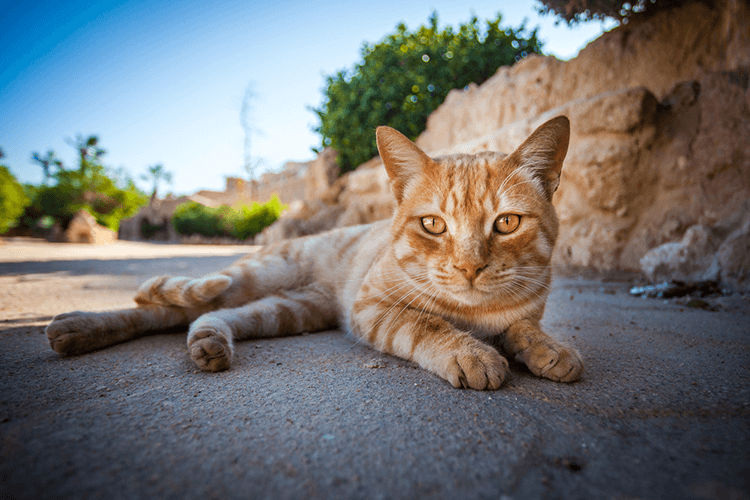All cultures are comprised of many significators such as religion, symbolism, and social behavior, and often, these pieces overlap. The way human beings interact with each other can arguably be one of the most paramount cultural identifiers. But today we’re going to take a look at how certain cultures interact with the most important members of society. (I’ll give you a hint; it’s cats.)
Throughout history, cats have found their way into many different cultural realms. They have been regarded as divine, and mysterious. Let’s take a look, shall we, at a few different cultures and their attitudes towards cats.
Vikings: Gods
Freyja is the Norse goddess of war, death, love, and wealth. She pretty much covers all the bases, being Queen Bee of the gods and all. But did you know that Freyja’s chariot is pulled by two mighty giant kitty cats, according to Norse mythology? Heck yeah! Your girl is out there riding into Valhalla with her 2 furry babies, given to her by Thor himself. As such, farmers would leave out offerings for all the local kitties (referred to as “fairy cats” – yes, “fairy cats”, in the local vernacular) in the hopes that such a deed would bring them a plentiful harvest. And why not? Cats are not only excellent rodent control when it comes to keeping your crops safe, but they’re just so dang cute. I mean come on.
Not only that, but a recent study suggests that the furry companions of Nords past might have even sailed aboard Viking ships as well! And the feline affinity doesn’t stop there. During wedding ceremonies, it was a common practice to give a new bride a wittle baby kitten as a wedding gift, in order to bring her and her new family good favor – not only with the gods, but with their agricultural endeavors as well. And if you ask me, I’m all for bringing that tradition back in style.
Middle Ages: Little Devils
Unfortunately, cats were not appreciated everywhere. During the Middle Ages in Europe, cats were thought to be spawns of the devil. And not just in the “hey Snowball can you literally stop knocking everything off my shelf, thanks” way, but more of like an “according to this thing I just made up, cats are actually sent from hell to spread evil and should be murdered on sight” way. Freaking rude if you ask me. On this topic, I’d suggest not digging around too much, because even though everything sucked in the Middle Ages, the persecution and ensuing torture of cats is a little bit too much for this cat lover to mull through.
Why all the hatred for cats during this time? Well, there are a few reasons. Most interestingly, cats were associated with the feminine, and during a time when everyone was dying and no one was happy, women were pinned as the scapegoats for everything – being burned at the stake for “witchcraft”. Hence the correspondence between witches and cat ownership. Oh, you caught the Black Death? Probably because you pet a cat. Sucks to be you. It couldn’t possibly because no one is remotely interested in personal hygiene or anything. Nope! It’s the gotta be the cats. Yup. Definitely the cats.
Native American: Spirit Animals
Many of us are familiar with Native American spirit animals, however, very few know what a spirit animal is or does. A spirit animal can be a celestial companion who guides you throughout your life, or a representation of who you truly are, and yes – cats are well represented. Throughout many Native American tribes, cats have played a significant role in their understanding of the world, which was (and still is) deeply spiritual and sacred.
Unfortunately, not all Native American tribes harbored positive feelings for our four-legged friends. The Oglala tribe, for instance, avoided cats at all costs, believing them to have the power to place horrible curses on those who would cross their path. In Wabanaki folklore, the wildcat figure Lusifee is presented as greedy, selfish, and malevolent.
Conversely, other tribes such as the Zuni tribe believe that the spiritual figure Wildcat has healing medicine. They would keep Wildcat’s likeness, carved out of stone, with them whenever they would go hunting. As totems, the cat is mostly associated with sensuality, mystery, and independence. Pretty fitting, don’t you think?
It comes as no surprise that cats are an important part of so many cultures. Be it spiritual or practical, every culture seems to have an opinion on cats. They take the starring roles in so many superstitions as well. So many, in fact, that it would be nearly impossible to document them all. But whether they’re revered as gods or feared as curses, in today’s world, cats reign supreme, and that’s exactly how it should be.







Moi, je possède six chats adorables et pleins damour qui sont toujours à mes côtés. Ils dorment sur mon lit, jouent ensemble, sentendent bien. Quelquefois, il y a des frictions mais cela ne dure pas. Tenez un exemple entrautres : Kalinka est arrivé chez moi à deux mois et a été pris en charge par Tigrette une de mes chattes âgées de quatorze ans et demi (à lépoque, elle avait sept ans). Puis, Kalinka a grandi et est devenu un gentil chat. Il a sept ans et demi aujourdhui et a accepté dans son groupe la présence de Ponpon (qui est devenu son fils adoptif), Freyja (qui maintenant nhabite plus chez moi et a pris la poudre descampette depuis septembre 2017), soeur adoptive de Ponpon, Thoret dit Toto, frère adoptif de Ponpon, Gustav-Adolph, dit Guguss, un gentil chartreux et Picpuss dit Pupuss Les rats et les souris ne viennent plus chez moi et se replient ailleurs.
Joyeux anniversaire à votre précieux bébé. Merci de partager vos histoires de vos merveilleux chats!